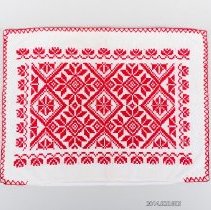Object Record
Images

Metadata
Collection |
Waterloo Region Museum |
Object ID |
2014.028.003 |
Object Name |
Cover, Cushion |
Description |
Rectangular cushion cover made from white linen. The linen used on the front of the cover is different than that used on the reverse. The front fabric is finer and heavier. The front is decorated with heavy, red embroidery. The pattern consists of stylized flowers with diamond shapes. The exterior edge of the cover is stitched in a V-shape except along the lower edge. The lower edge is open and the cover may be unfinished. There is no embroidery on the reverse. Cover is machine-sewn. |
Date |
1940 |
Date |
1945 |
Dimensions |
H-40 W-54 cm |
History |
According to the donor, Maria Dienesch (1925-2013) was born in Birk, Romania, part of the Transylvania region. The family were ethnic Germans. At age 16 she married Andreas Gellner (1920-1941), who was killed during the Second World War. When the Russian Army began to advance into their region, the family moved by horse and carriage to the west to escape. At some point their horses were taken by the German military, and the family was loaded onto a train for the journey into Germany. Once the family was settled in Germany, they thought they would move to Canada. Maria came first, arriving in Quebec City onboard the Beaverbrae in the spring of 1950. She then took a train to Kitchener where she was met by her sponsors, as well as some people from her old village. When Maria arrived she didn't speak English, not even "yes" or "no". She got a job at the Westmount Golf and Country Club and began learning English. Meanwhile back in Germany, her brother had married so her parents decided to stay there. Maria was all alone in Canada. She had been corresponding with a young man named Hans Hamberger (1926-1995) in Germany. He was a rich young bachelor and the son of a respected railway builder. The idea of their son marrying a refugee and a widow was not well received but Hans was determined. Maria advised him that "to come to Canada you would have to be related or be my finance". Hans wrote back "consider yourself engaged". On May 1st, 1951 Hans arrived at the Kitchener train station, and the couple married shortly after his arrival as the immigration rules insisted that they marry promptly. From that point on, much to Maria's frustration, Hans would tell people "we had to get married". The Beaverbrae sailed every 28 days between 1948 and 1954, bringing displaced persons, mostly ethnic Germans, from Europe to Canada. The ship completed 52 trips, bringing approximately 33,000 people to Canada. The Beaverbrae was operated jointly by the Canadian Pacific Steamship Company, the Government of Canada, and the Canadian Christian Council for the Resettlement of Refugees. Many of these refugees were aided by faith churches, mostly notably the Canadian Luthern World Relief. A Beaverbrae reunion has been held several times at the Bethel Evangelical Luthern Church in Kitchener. |
People |
Hamberger, Maria Dienesch Gellner |


